History
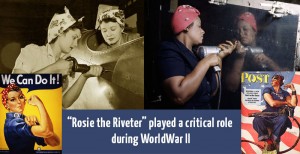 During World War II, when many of the men were involved in the fighting over seas, a group of women stepped up and filled the gap as welders working in the bomber plants. They became known as Rosie the Riveter, and there were thousands of them. It really became a movement of female empowerment, and I don’t know how the war would have gone without them. It was a movement of solidarity. They worked to keep the American Army Air Forces in much needed bombers. There were men who were riveters too, including my Uncle Bill Spencer, who was turned down for the service because of flat feet and a hernia, but most of them were women, and they
During World War II, when many of the men were involved in the fighting over seas, a group of women stepped up and filled the gap as welders working in the bomber plants. They became known as Rosie the Riveter, and there were thousands of them. It really became a movement of female empowerment, and I don’t know how the war would have gone without them. It was a movement of solidarity. They worked to keep the American Army Air Forces in much needed bombers. There were men who were riveters too, including my Uncle Bill Spencer, who was turned down for the service because of flat feet and a hernia, but most of them were women, and they 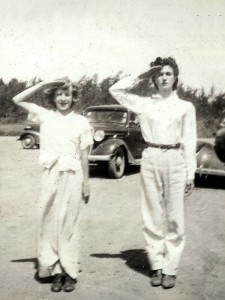 included my Aunt Laura Spencer and my Aunt Ruth Spencer. It was a time when it was all hands on deck…our fighting airmen needed our help and support. One of those fighting airmen was my dad, Allen Spencer, brother to Laura, Bill, and Ruth. I’m sure it seemed to them, the best way they could help their brother, and all the other airmen.
included my Aunt Laura Spencer and my Aunt Ruth Spencer. It was a time when it was all hands on deck…our fighting airmen needed our help and support. One of those fighting airmen was my dad, Allen Spencer, brother to Laura, Bill, and Ruth. I’m sure it seemed to them, the best way they could help their brother, and all the other airmen.
The other day, I came across an article in the paper about the Willow Run bomber plant in Willow Run, Michigan. It would seem that this little slice of history is set to go on the chopping block. I suppose that not every historic landmark can be saved, but it seems such a horrible shame to tear down a building that marked such a heroic effort by so many people, to stand behind a nation at war, by meeting such an enormous need. Between 1942 and 1945, crews numbering tens of thousands built roughly one B-24 Liberator an hour…8,685 in all. There were women all over the country performing the work that had always been done by men, but at the Willow Run plant, one Rose Will Monroe worked alongside 40,000 other workers…mostly women…and soon she became the trademark…Rosie the Riveter. Before long, 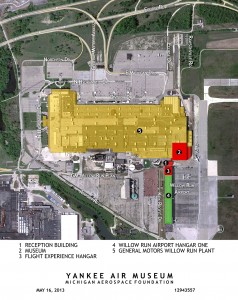 all those women were known as Rosie the Riveters…and they considered it an honor to bear the title.
all those women were known as Rosie the Riveters…and they considered it an honor to bear the title.
Now, the Willow Run bomber plant is in peril. Those who remember the trademark Rosies, want to keep their history alive, but in order to do so, they need 8 million dollars. They don’t have much time to raise the money. They are at a remarkable 7.23 million dollars right now. To me it would be a horrible shame to let this little slice of history be destroyed. I feel like it is so uncharacteristic of this nation to forget the efforts of our heroes in any area of American life. It is my hope that this historic landmark can be saved, so that our children, and our children’s children can see what can be accomplished when we work together. More information on this can be found at Save The Willow Run Bomber Plant.
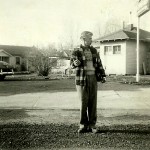 Many years ago, when things were much safer, there was a habit that a lot of people engaged in, that today, in our time, parents would cringe about and warn their children against…hitchhiking. Kids used to hitchhike to get to work, to a friends house, to town, or wherever they might be going. They didn’t have enough money to buy a car of their own, and it was a pretty much unheard of item to have, so I guess they assumed that anyone who had a car was a nice enough person, and they would hitch a ride from them. Usually they were right, and nothing bad happened, but later on, as this world got a little uglier, taking a ride from someone was something you did at your own risk, because you never knew what you were getting into.
Many years ago, when things were much safer, there was a habit that a lot of people engaged in, that today, in our time, parents would cringe about and warn their children against…hitchhiking. Kids used to hitchhike to get to work, to a friends house, to town, or wherever they might be going. They didn’t have enough money to buy a car of their own, and it was a pretty much unheard of item to have, so I guess they assumed that anyone who had a car was a nice enough person, and they would hitch a ride from them. Usually they were right, and nothing bad happened, but later on, as this world got a little uglier, taking a ride from someone was something you did at your own risk, because you never knew what you were getting into.
Since my dad and his brother had a habit of jumping onto the slow moving train when they wanted a ride, even though they had a pass, and therefore had no need to jump onto the train, it would be my assumption that they probably hitchhiked too. Of course, they also had a real love for cars too, and therefore my guess would be that they were more likely to be the ones picking up the hitchhiker, not being the hitchhiker. Nevertheless, that isn’t really safe these days either.
I have been in a position where I had to take the help of a stranger, and I must say, I did not like it, but it was cold, the car had broken down, I had my girls with me, and it was still a long walk home. Thankfully the person I tool the ride from was a neighbor in the area we lived in, and we became friends with them after that. Nevertheless, at the time of the ride, it was a risky move to take that ride, and one I very much hated to take.
Over the years, Bob and I have picked up several people who were in a bad situation. They weren’t hitchhiking exactly, but like me, they knew that if they didn’t take the ride, they probably wouldn’t get home anyway. One was a couple whose car broke down, and the temperature that New Year’s Day at 3:00 in the morning was about 15° below zero, gratefully accepted our offer for a ride, and after driving the about 4 miles to their home, I have no doubt that they would have died that night, had we not helped them. Another was a couple who had slid off the road on snow and almost into the river, and no one had stopped in more that half and hour. We took them to town. Who knows how long they would have been there.
Hitchhiking in days gone by was not nearly as risky as it use to be, but any time you take a ride from someone you don’t know, or pick up someone you don’t know, in the old west, or today, you are putting your life at risk. So, while my dad may have done it, and probably knew the boy in this picture who was doing it, hitchhiking is not something I would recommend today.
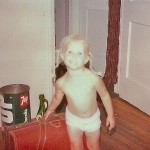
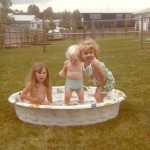 Kids have always been…well, a little more open and free with their thoughts on things like the need to wear clothes. With summer upon us, people begin to think about things like the lake, the town pool, or for the little kids, the wading pool. If the kids are little enough, they can get away with swimming in just their underwear, and nobody cares. Of course, later on, things are a bit different…at least for the girls. The boys could practically swim in the underwear most of them wear today, because boxers look a lot like swim trunks.
Kids have always been…well, a little more open and free with their thoughts on things like the need to wear clothes. With summer upon us, people begin to think about things like the lake, the town pool, or for the little kids, the wading pool. If the kids are little enough, they can get away with swimming in just their underwear, and nobody cares. Of course, later on, things are a bit different…at least for the girls. The boys could practically swim in the underwear most of them wear today, because boxers look a lot like swim trunks.
To little kids, however, I’m not so sure that it is just swimming that makes them think that clothes are strictly optional. It seems to me that just about every kid decides that the moments after a bath are the perfect moment for them to become a little streaker. Back in the seventies, when I was in high school, some of the students even tried their hand a streaking. Of course, most of us either didn’t dare, or weren’t so inclined to running around naked. Little kids, however, have no such inhibitions…in fact, being in the buff is pretty much their favorite thing. I can’t say that I would like to be so free again, but little kids do have a great time trying to get away with as little clothing as possible.
I have known several parents who have talked about their own little streakers, and it would seem that at some point, every parent finds themselves with one of these little rebels. It’s hard not to laugh at them, even as you are trying to catch them. One of the funniest things though, is when your little streaker decides that the best time to make a run for it, is when you have company at the house. Even though many of these parents have been in the same position, they still can’t help but laugh when it is someone else in that position.
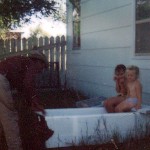

Of course, as they get older, most kids stop the full streak habit, but for many of them, it is real easy to stay in the partial streak mode…especially the men. I mean really, and be honest here, how many men still love to sit around the house in their underwear? More of them than will want to admit it, I’m sure. I guess the truth be told, there is a little bit of the Streak in all of us, but some of us just don’t ever outgrow it.
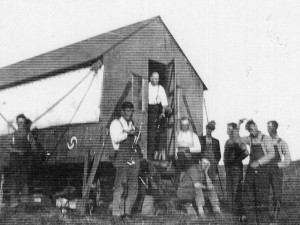 Yesterday, I came across some old pictures from my mom’s side of the family, and as I looked at the list Aunt Sandy had given me, I had to do a double take. It wouldn’t seem like it was such a big deal, because it just a picture of some unnamed ranch hands from the Flying U Ranch in Rushville, Nebraska. To someone who didn’t know anything about Rushville, Nebraska, this find would be nothing really, but I do know a little bit about Rushville, Nebraska, although I don’t recall ever having been there. I’m sure that seems odd…I mean, how could I know anything about this place if I haven’t ever been there? I could have studied about it I suppose, but for me, it is more about the people who were there at a certain time in history, than it is about the place itself.
Yesterday, I came across some old pictures from my mom’s side of the family, and as I looked at the list Aunt Sandy had given me, I had to do a double take. It wouldn’t seem like it was such a big deal, because it just a picture of some unnamed ranch hands from the Flying U Ranch in Rushville, Nebraska. To someone who didn’t know anything about Rushville, Nebraska, this find would be nothing really, but I do know a little bit about Rushville, Nebraska, although I don’t recall ever having been there. I’m sure that seems odd…I mean, how could I know anything about this place if I haven’t ever been there? I could have studied about it I suppose, but for me, it is more about the people who were there at a certain time in history, than it is about the place itself.
I have long known that some of my dad’s family settled in Rushville, Nebraska. In fact, I have written about them several times. My dad’s Great Aunt Theresa Elizabeth Spencer and her husband, William Jonathan Davis lived most of their married life in Rushville, Nebraska, and had a big ranch there. Several of their children also had ranches in the area. The name of the Davis ranch was Pine Creek, and interestingly enough, it is currently for sale, with 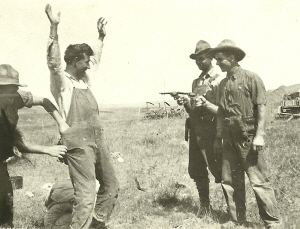 an asking price of $795,000.00, a fact that I found a bit sad, because it is a bit of my family history, and it will soon be owned by someone new, if it wasn’t already.
an asking price of $795,000.00, a fact that I found a bit sad, because it is a bit of my family history, and it will soon be owned by someone new, if it wasn’t already.
I haven’t been able to find the Flying U Ranch so far, but I know that it is…or was…in the Rushville, Nebraska area. The Flying U Ranch was not owned by my mom’s family, but it could have been. The couple who owned the ranch was getting older, and they apparently didn’t have children or children who were still living or able to take over the ranch. They really liked my grandfather, George Byer, and they told him that if he would stay there, in Rushville, they would deed the ranch to him upon their deaths. I don’t know if Grandpa didn’t like the area, or if he thought it was too long to wait and not know when he would inherit the ranch, or if he didn’t really like the ranching life, but for whatever reason, he chose not to take them up on that generous offer. I’m sure they were sorry that he didn’t, but I don’t know who they eventually gave the ranch to or if they sold it, but it did not end up in our family.
As for me, the questions that remain, are more along the lines of…Did Grandpa ever regret his decision to pass on the Flying U Ranch?…and Did he know some of the Davis family, thereby tying  the two sides of my family together long before the marriage of my parents in 1953. He obviously had some great times on the Flying U Ranch…after all, it was there that he and some of the ranch hands took pictures of their staged robbery. They must have enjoyed spending time together just goofing off. I also have to wonder how our lives might have been different, had Grandpa taken on the Flying U ranch? I had never really considered what it might have been like if we had descended from a rancher. I don’t know that I would change anything about my life, even if I could, but it is interesting to look at the possibilities when one reflects on the fact that it really is a small world.
the two sides of my family together long before the marriage of my parents in 1953. He obviously had some great times on the Flying U Ranch…after all, it was there that he and some of the ranch hands took pictures of their staged robbery. They must have enjoyed spending time together just goofing off. I also have to wonder how our lives might have been different, had Grandpa taken on the Flying U ranch? I had never really considered what it might have been like if we had descended from a rancher. I don’t know that I would change anything about my life, even if I could, but it is interesting to look at the possibilities when one reflects on the fact that it really is a small world.
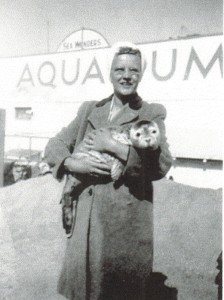 Back in 1946, my Aunt Doris and Uncle Bill decided that they were tired of the bitter cold Wisconsin weather, and that they wanted to try a warmer climate. Uncle Bill had built a travel trailer, and they quit their jobs and headed west. It was a bold move to make, because you never knew what the economy was going to be like in California, or any other part of the country for that matter. The depression was over though, and people were hopeful. I’m quite certain that the warm weather must have felt so good to them, and while there they enjoyed many of the sights. They really didn’t plan to ever go back to Wisconsin.
Back in 1946, my Aunt Doris and Uncle Bill decided that they were tired of the bitter cold Wisconsin weather, and that they wanted to try a warmer climate. Uncle Bill had built a travel trailer, and they quit their jobs and headed west. It was a bold move to make, because you never knew what the economy was going to be like in California, or any other part of the country for that matter. The depression was over though, and people were hopeful. I’m quite certain that the warm weather must have felt so good to them, and while there they enjoyed many of the sights. They really didn’t plan to ever go back to Wisconsin.
So many things can change in such a short time. Parents get older, and their health fades, and before long, you find yourself needed back home. That was the situation they soon found themselves in, and with some regret, they headed back home. Sometimes, that is the way things have to be. They were in a position to help out and others weren’t. It’s is strange, nevertheless, how quickly you can long for home, once you have made up your mind to go. I think it is harder 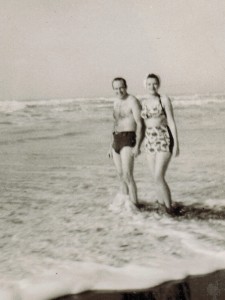 sometimes on the women to be so far from parents too, because they are a little more sentimental usually.
sometimes on the women to be so far from parents too, because they are a little more sentimental usually.
Still, I have to think that the adventure they had while they were in California and the west coast must have been something they cherished for many years. They got to hold a seal at an aquarium, and stroll along the beach, soaking up the California sun. They saw the Redwood trees, and the rocky coast of Oregon. The memories must have been awesome, because they were free to pick up and go where they chose to each day. Of course, that is never something you can do for very long…at least not until retirement age, but for a while, they got to enjoy that carefree life, and the beauty of the west coast. Today is my Aunt Doris’ 90th birthday. Happy birthday Aunt Doris!! You are still just as beautiful today as you were back then. Have a wonderful day!! We love you!!
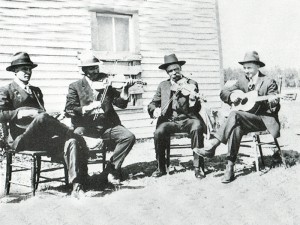 Many years ago, radios were not as common, and could not be used outside the home, so when families would gather together for a dinner or dance, music by radio was not really an option. I think people probably learned to play instruments so they could entertain themselves and others. Music has been a part of my family’s heritage for a far back as I have been able to trace, but it has taken many different twists and turns. This picture is one of my Uncle Bill’s favorites. He calls it “The Musicians”, which is exactly what it is, but it was named with a little mix of respect and sentiment that said what a special thing Uncle Bill thought the little group was. My grandfather
Many years ago, radios were not as common, and could not be used outside the home, so when families would gather together for a dinner or dance, music by radio was not really an option. I think people probably learned to play instruments so they could entertain themselves and others. Music has been a part of my family’s heritage for a far back as I have been able to trace, but it has taken many different twists and turns. This picture is one of my Uncle Bill’s favorites. He calls it “The Musicians”, which is exactly what it is, but it was named with a little mix of respect and sentiment that said what a special thing Uncle Bill thought the little group was. My grandfather 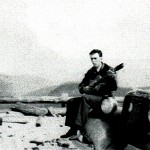 had taught each of his kids to play the violin, so they knew what it took to play music. It took a lot of practice and if you were going to play at dances and such, you had to pack all of your equipment and go to where the dance was and play, often late, then pack up and go home…all in a covered wagon way back then.
had taught each of his kids to play the violin, so they knew what it took to play music. It took a lot of practice and if you were going to play at dances and such, you had to pack all of your equipment and go to where the dance was and play, often late, then pack up and go home…all in a covered wagon way back then.
Nevertheless, even with all of the work and such, musicians who really loved what they did, made the sacrifice, and the rest of the people were glad, because a good band can be hard to find. Barn dances, square dances, and other such functions would not be the same without the musicians who made them possible. Those barn dances were the thing that the people looked forward to all week, or sometimes all month. It was like out going to a show these days. If you didn’t get to go, and it was planned, you were really bummed out.
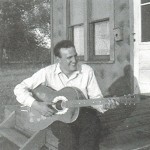
I remember taking square dancing in school, and how much we hated that, but to those people, it was the latest thing. When you think about it, square dancing probably was the start of the line dancing of today, just like the music was the beginning of some of the music of today…at least the country music. It’s funny how much music has changed over the years, and yet really the musicians have not changed all that much…other than in looks. They still devote a lot of time to practice and work really hard to perfect their art. Whether it is country, contemporary, or even rock, being a good musician takes a lot of dedication in order to become great.
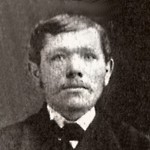 On this, the 130th anniversary of the arrival of my great grandfather, Carl Ludwig Theodor Schumacher in the United States, I have been thinking about how it must have felt for him. He had made the most difficult decision to leave his homeland at the very young age of 25, and board the SS Gellert, leaving from Hamburg, Germany on April 6, 1884 to start a new life, far away from his parents and family in the United States of America. He had been reading letters from his uncle and cousins about how wonderful America was, and in particular, how wonderful Minnesota was, since he was 18, and he had made up his mind to go. He would work seven long years taking care of the horses of a wealthy landowner to earn the $50.00 needed to pay his fare. He knew that travel by ship across the Atlantic could be dangerous, and he might be very homesick for his family, but he was determined to go. He knew, also that it would take years of hard work to build the American Dream that he had in mind for his life. My great grandfather would be successful in building his American Dream, but today my thoughts go not to thinking of his dreams, but rather to how he must have felt as he made such a life change.
On this, the 130th anniversary of the arrival of my great grandfather, Carl Ludwig Theodor Schumacher in the United States, I have been thinking about how it must have felt for him. He had made the most difficult decision to leave his homeland at the very young age of 25, and board the SS Gellert, leaving from Hamburg, Germany on April 6, 1884 to start a new life, far away from his parents and family in the United States of America. He had been reading letters from his uncle and cousins about how wonderful America was, and in particular, how wonderful Minnesota was, since he was 18, and he had made up his mind to go. He would work seven long years taking care of the horses of a wealthy landowner to earn the $50.00 needed to pay his fare. He knew that travel by ship across the Atlantic could be dangerous, and he might be very homesick for his family, but he was determined to go. He knew, also that it would take years of hard work to build the American Dream that he had in mind for his life. My great grandfather would be successful in building his American Dream, but today my thoughts go not to thinking of his dreams, but rather to how he must have felt as he made such a life change.
A young man of 25 years is really not so grown up that a move half a world away doesn’t feel scary. That kind of a move would be a daunting experience for anyone, no matter how 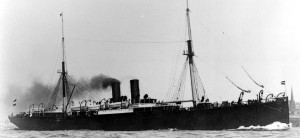 old they are. And then to arrive at a place like Ellis Island, or in my grandfather’s case, Castle Garden, since the Ellis Island facility wasn’t built until 1892…not really knowing what you would be put through before you would be allowed to enter the United States. Many people were required to Americanize their names, so it would be easier for them to fit in…forever altering their identity. That was the case for my great grandfather, when his name was changed from Schuhmacher to Schumacher. Still, the immigrants felt like this was a small sacrifice to make for the gain of the American Dream, and in fact, many immigrants felt like that name change was like a rite of passage into this great country.
old they are. And then to arrive at a place like Ellis Island, or in my grandfather’s case, Castle Garden, since the Ellis Island facility wasn’t built until 1892…not really knowing what you would be put through before you would be allowed to enter the United States. Many people were required to Americanize their names, so it would be easier for them to fit in…forever altering their identity. That was the case for my great grandfather, when his name was changed from Schuhmacher to Schumacher. Still, the immigrants felt like this was a small sacrifice to make for the gain of the American Dream, and in fact, many immigrants felt like that name change was like a rite of passage into this great country.
Nevertheless, I can’t help but feel that my grandfather must have felt some level of sadness at the change of his name, even though he would use it again when he was married. Still, the census records, and other records show it as Schumacher, thus muddying the waters when it comes to genealogy records. I don’t suppose that was the 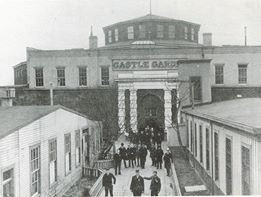 thing my great grandfather was thinking about as he waited for his turn at Castle Garden on April 21, 1884, but as my mind looks back in time to that day that would end up being so very important to my life, it is something that definitely occurs to me. My great grandfather had been through so much to come to this new land filled with opportunity, and I’m quite certain that the overwhelming changes must have made him quite weary, but as he arrived in Minnesota and began the work of building that dream, I suppose that all of the uncertainty of the journey to get where he was, became simply a distant memory. He was home…the home of his dreams.
thing my great grandfather was thinking about as he waited for his turn at Castle Garden on April 21, 1884, but as my mind looks back in time to that day that would end up being so very important to my life, it is something that definitely occurs to me. My great grandfather had been through so much to come to this new land filled with opportunity, and I’m quite certain that the overwhelming changes must have made him quite weary, but as he arrived in Minnesota and began the work of building that dream, I suppose that all of the uncertainty of the journey to get where he was, became simply a distant memory. He was home…the home of his dreams.
 Every Easter families gather together to eat a big meal and enjoy each other’s company. Most of us use just about any excuse to have a huge meal filled with all the best dishes we can think of. The meal often consists of ham and brisket at our house. And of course, what Easter dinner would be complete without eggs in some form…usually for breakfast and dinner. All those eggs the kids colored had to be used in some way, after all. In our family, the eggs are called angel eggs, because for obvious reasons, we don’t like the term deviled eggs. I really don’t want the devil involved in anything in my family…even the eggs.
Every Easter families gather together to eat a big meal and enjoy each other’s company. Most of us use just about any excuse to have a huge meal filled with all the best dishes we can think of. The meal often consists of ham and brisket at our house. And of course, what Easter dinner would be complete without eggs in some form…usually for breakfast and dinner. All those eggs the kids colored had to be used in some way, after all. In our family, the eggs are called angel eggs, because for obvious reasons, we don’t like the term deviled eggs. I really don’t want the devil involved in anything in my family…even the eggs.
But, more importantly, as Christians, we come together to remember the sacrifice our Lord and Saviour, Jesus Christ made to save us from our sins. We were in a horrible mess. We had all sinned, and there was no way out of going to Hell…not that we could manage anyway. Nevertheless, God is a loving God, and His children really are His life. He devised a plan to save us from the mess we were in. He sent his son, Jesus, who left His home in Heaven to come to earth, as a man, to live a sinless life, and then to die on the cross anyway, because it was the only way out for us. A sinless man had to die to pay the price for a world of sinners.
I saw a post yesterday on Facebook with the message, “Friday happened, but Sunday is coming.” That is so true. There is nothing we can do about the fact that our sins caused the 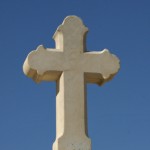 need for a Saviour, Jesus to come and die to save us. That is in the past, but our future is eternal in Heaven, because of the selfless act of our Saviour. It is God’s love, grace and mercy toward his children that allows us to walk away from the punishment we all deserved, and live forever with Him. We can never thank Him enough for sending His Son. We can never thank Jesus enough for choosing to come and die in our place. All we can do now is rejoice!! Friday happened, but Sunday came three days later, because God so loved the world, that He gave His only begotten Son!! Jesus willingly paid the price, defeated the devil, and the rose again to proclaim that victory!! Sunday is here!! He is risen!!! Jesus is alive!! Rejoice!!
need for a Saviour, Jesus to come and die to save us. That is in the past, but our future is eternal in Heaven, because of the selfless act of our Saviour. It is God’s love, grace and mercy toward his children that allows us to walk away from the punishment we all deserved, and live forever with Him. We can never thank Him enough for sending His Son. We can never thank Jesus enough for choosing to come and die in our place. All we can do now is rejoice!! Friday happened, but Sunday came three days later, because God so loved the world, that He gave His only begotten Son!! Jesus willingly paid the price, defeated the devil, and the rose again to proclaim that victory!! Sunday is here!! He is risen!!! Jesus is alive!! Rejoice!!
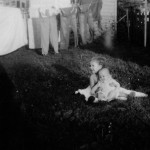 It’s funny how some of the most insignificant things can spark a memory of childhood that takes you back decades in an instant. As I was looking through some old pictures, from when I was about 4 months old, I noticed something at the edge of the picture. My sister, Cheryl and I were the main focus of the picture my mom was taking, but she also go a picture of the clothes hanging on the clothesline. Many home still have that clothesline in the back yard. For most of those homes, it is a forgotten relic of many years now in the past. Most people don’t bother hanging their clothes on the line to dry. We have a dryer sitting right next to the washer for that job. Of course, if we want to get that sunshine fresh scent to them, we have to as a chemically infused dryer sheet to the dryer, because otherwise they simply get dry…nothing more.
It’s funny how some of the most insignificant things can spark a memory of childhood that takes you back decades in an instant. As I was looking through some old pictures, from when I was about 4 months old, I noticed something at the edge of the picture. My sister, Cheryl and I were the main focus of the picture my mom was taking, but she also go a picture of the clothes hanging on the clothesline. Many home still have that clothesline in the back yard. For most of those homes, it is a forgotten relic of many years now in the past. Most people don’t bother hanging their clothes on the line to dry. We have a dryer sitting right next to the washer for that job. Of course, if we want to get that sunshine fresh scent to them, we have to as a chemically infused dryer sheet to the dryer, because otherwise they simply get dry…nothing more.
I remember, as a kid doing chores, that one of those chores was to hang the clothes on the line, and later to bring them in, fold them, and put them away. Of course, the clothes didn’t have that dryer induced softness, and so they might feel a bit scratchy at first, but that sunshine fresh scent was wonderful. It wasn’t the heavily perfumed scent that the dryer sheet produces, but rather the light scent of fresh air. I suppose that if you didn’t pay close attention, you could miss that scent, and therefore would think it was probably just my imagination, but I can say that I hung enough clothes on the clothesline to know what that scent smelled like, and I liked it, even if I didn’t really like the chore of hanging and folding those clothes.
These days, I dry my clothes in the dryer, because quite frankly, like most people I know, 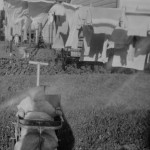 I don’t have time to spend hanging those clothes, waiting for them to dry, hoping the wind doesn’t blow them away, and taking them back down, before folding them and putting them away. The modern conveniences of the day win out in this day and age. And in reality, I suppose, seeing the clothes on the line in these pictures didn’t make me want to go hang clothes on the line, but rather it reminded me of the days gone by. The simple days of childhood, when the hardest chore was something like cleaning my room or handing clothes on the clothesline. We were so free then. No real obligations…we didn’t even have a part time job. We were kids, we did kid things, and we were living a carefree kid kind of life.
I don’t have time to spend hanging those clothes, waiting for them to dry, hoping the wind doesn’t blow them away, and taking them back down, before folding them and putting them away. The modern conveniences of the day win out in this day and age. And in reality, I suppose, seeing the clothes on the line in these pictures didn’t make me want to go hang clothes on the line, but rather it reminded me of the days gone by. The simple days of childhood, when the hardest chore was something like cleaning my room or handing clothes on the clothesline. We were so free then. No real obligations…we didn’t even have a part time job. We were kids, we did kid things, and we were living a carefree kid kind of life.
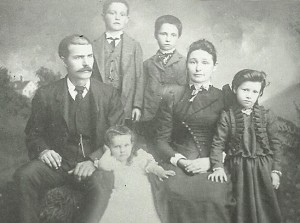 I have often wondered why people didn’t smile in pictures taken many years ago. It didn’t really make sense to me, because it seems that most people were happy with their lives. So why not show that they were happy in the pictures that were taken to remember them. Weren’t these pictures were intended to show their descendants who they were and tell a little bit about their lives? I always thought that it was a bit sad that there were so few smiles. And I have wondered why people didn’t tell their kids to smile, but upon further thought, and a look at the picture of my in-laws with all the grandchildren they had at that time, I think maybe I now have a little bit better understanding of it. Maybe it wasn’t totally intended at all, or maybe it was. I suppose we will never know.
I have often wondered why people didn’t smile in pictures taken many years ago. It didn’t really make sense to me, because it seems that most people were happy with their lives. So why not show that they were happy in the pictures that were taken to remember them. Weren’t these pictures were intended to show their descendants who they were and tell a little bit about their lives? I always thought that it was a bit sad that there were so few smiles. And I have wondered why people didn’t tell their kids to smile, but upon further thought, and a look at the picture of my in-laws with all the grandchildren they had at that time, I think maybe I now have a little bit better understanding of it. Maybe it wasn’t totally intended at all, or maybe it was. I suppose we will never know.
I was there when these newer pictures were taken, of course, so I know for sure what was going on. We had taken pictures of several families, and multiple other group shots. We had been through the fidgety kids, the bouts of tears, the laughing at the ones in tears, and we were past nap time for some of these kids. We did our very best to get them to smile for the camera, and most of the time they did pretty good. Nevertheless, by the time we got to this picture, we were pretty much over the picture taking, and no one was doing any smiling. Sometimes there is just simply nothing you can do about a bad picture, except to chalk it up to experience, and move on. You can hope that the next time pictures are taken, everyone will be in a better mood, but quite likely you will find that there will be at least one or two who will feel the same way next time as they did this time.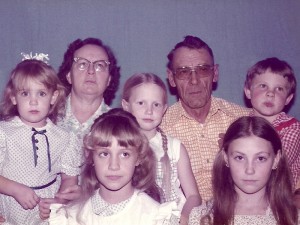
Looking back in those old pictures, I thought maybe it wasn’t a matter of collectively deciding not to smile. Maybe they had work to be done on the farm, and they didn’t really want to be there taking pictures. Or maybe they just hated being all dressed up in their Sunday best on a week day, or maybe the kids were fussy and needed a nap, and maybe they were just tired. I mean, after all, everything was a lot harder then. They didn’t have the modern conveniences we have today. Maybe they were just too tired to smile!

